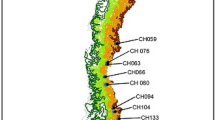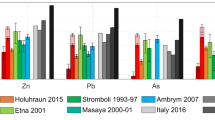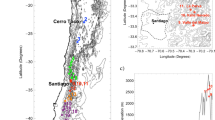Abstract
Persistent, semi-volatile organochlorine compounds, including toxic industrial pollutants and agricultural pesticides, are found everywhere on Earth, including in pristine polar and near-polar locations1,2,3,4. Higher than expected occurrences of these compounds in remote regions are the result of long-range transport in the atmosphere, precipitation and ‘cold condensation’ — the progressive volatilization in relatively warm locations and subsequent condensation in cooler environments3,4 which leads to enhanced concentrations at high latitudes. The upper reaches of high mountains are similar to high-latitude regions in that they too are characterized by relatively low average temperatures, but the accumulation of organochlorine compounds as a function of altitude has not yet been documented. Here we repororganochlorine deposition in snow from mountain ranges in western Canada that show a 10- to 100-fold increase between 770 and 3,100 m altitude. In the case of less-volatile compounds, the observed increase by a factor of 10 is simply due to a 10-fold increase in snowfall over the altitude range of the sampling sites. In the case of the more-volatile organochlorines, cold-condensation effects further enhance the concentration of these compounds with increasing altitude. These findings demonstrate that temperate-zone mountain regions, which tend to receive high levels of precipitation while being close to pollutant sources, are particularly susceptible to the accumulation of semivolatile organochlorine compounds.
This is a preview of subscription content, access via your institution
Access options
Subscribe to this journal
Receive 51 print issues and online access
$199.00 per year
only $3.90 per issue
Buy this article
- Purchase on Springer Link
- Instant access to full article PDF
Prices may be subject to local taxes which are calculated during checkout



Similar content being viewed by others
References
Donald, D. B. et al . Polychlorinated Biphenyls and Organochlorine Pesticides in the Aquatic Environment along the Continental Divide Region of Alberta and British Columbia (Spec. Rep. Inland Waters Directorate, Environment Canada, Regina, Saskatchewan, 1993).
Welch, H. E. et al . Brown snow: a long-range transport event in the Canadian Arctic. Environ. Sci. Technol. 25, 280–286 (1991).
Wania, F. & Mackay, D. Global fractionation and cold condensation of low volatility organochlorine compounds in polar regions. Ambio 22, 10–18 (1993).
Simonich, S. L. & Hites, R. A. Global distribution of persistent organochlorine compounds. Science 269, 1851–1854 (1995).
Miskimmin, B. et al . Chlorobornanes in sediments and fish thirty years after toxaphen treatment of lakes. Environ. Sci. Technol. 29, 2490–2495 (1995).
Campbell, L. M. The Use of Stable Isotope Ratios to Discern Organochlorine Bioaccumulation Patterns in a Sub-alpine Rocky Mountain Lake Food Web.Thesis, Univ. Alberta (1997).
Kidd, K. A. et al . High toxaphene concentrations in fish from a subarctic lake. Science 269, 240–242 (1995).
Kidd, K. A. et al . Correlation between stable nitrogen isotope ratios and concentrations of organochlorines in biota from a freshwater food web. Sci. Tot. Environ. 160/161, 381–390 (1995).
Weathers, K. C. et al . Aregional acidic/fog water event in the eastern United States. Nature 319, 657–658 (1986).
Baltensperger, U. et al . Transfer of atmospheric constituents into an alpine snow field. Atmos. Environ. A 27, 1881–1890 (1993).
Muir, D. C. G. et al . Organochlorine contaminents in arctic marine food chains: accumulation of specific polychlorinated biphenyls and chlordane-related compounds. Environ. Sci. Technol. 22, 1071–1079 (1988).
Muir, D. C. G. et al . Spatial trends and historical profiles of organochlorine pesticides in Arctic lake sediments. Sci. Tot. Environ. 160/161, 447–457 (1995).
Hinckley, D. A. et al . Determination of vapor pressures for nonpolar and semipolar organic compounds from gas chromatographic retention data. J. Chem. Eng. Data 35, 323–237 (1990).
Muir, D. C. G. et al . Spatial trends and historical deposition of polychlorinated biphenyls in Canadian mid-latitude and arctic lake sediments. Environ. Sci. Technol. 30, 3609–3617 (1996).
Muir, D. C. G. et al . Geographic variation of chlorinated hydrocarbons in burbot (Lota lota) from remote lakes and rivers in Canada. Arch. Environ. Contam. Toxicol. 19, 530–542 (1990).
Gregor, D. J. in Seasonal Snowpacks (ed. Davies, T.) 323–358 (NATO Ser. G, Vol. 28, Springer, Berlin, 1991).
Wania, F. Modelling the fate of non-polar organic chemicals in an aging snowpack. Chemosphere 35, 2345–2363 (1997).
Metcalf, R. L. Organic Insecticides, their Chemistry and Mode of Action (Interscience, New York, 1955).
Canadian Arctic Contaminant Assessment Report (Minister of Public Works and Government Services, Ottawa, Canada, 1997).
Schindler, D. W. & Pacas, C. in Ecological Outlooks Project (eds Green, J., Pacas, C., Bayley, S. & Cornwall, L.) (Banff-Bow Valley Study, Dept of Canadian Heritage, Ottawa, 1996).
Mackay, D., Shiu, W. Y. & Ma, K.-C. Illustrated Handbook of Physical-Chemical Properties and Environmental Fate for Organic Chemicals Vol. V (Lewis Publishers, Boca Raton, FL, 1997).
Mackay, D., Shiu, W. Y. & Ma, K.-C. Illustrated Handbook of Physical-Chemical Properties and Environmental Fate for Organic Chemicals Vol. 1. Monoaromatic Hydrocarbons Chlorobenzenes and PCBs (Lewis Publishers, Chelsea, Michigan, 1992).
Acknowledgements
We are grateful to the Banff Warden Office, in particular D. Gilbride, for help with locating weather stations and providing meteorological data. We thank the ski patrol crews from Lake Louise, Sunshine, Tod and Whistler ski mountains for their support and interest. Sample fractionation and GC analyses were conducted at the Freshwater Institute, Winnipeg. R. Crosley and L. Mottle from Environment Canada, Calgary, supplied expertise, sampling equipment and laboratory facilities for this work. This work was supported by the Canadian Chlorine Coordinating Committee (C4), an NSERC Strategic Grant, and an NSERC Operating Grant (D.W.S.).
Author information
Authors and Affiliations
Corresponding author
Rights and permissions
About this article
Cite this article
Blais, J., Schindler, D., Muir, D. et al. Accumulation of persistent organochlorine compounds in mountains of western Canada. Nature 395, 585–588 (1998). https://doi.org/10.1038/26944
Received:
Accepted:
Issue Date:
DOI: https://doi.org/10.1038/26944
This article is cited by
-
Substantial halogenated organic chemicals stored in permafrost soils on the Tibetan Plateau
Nature Geoscience (2023)
-
Freely dissolved organochlorine pesticides (OCPs) and polychlorinated biphenyls (PCBs) along the Indus River Pakistan: spatial pattern and risk assessment
Environmental Science and Pollution Research (2022)
-
Soil erosion and sediment dynamics in the Anthropocene: a review of human impacts during a period of rapid global environmental change
Journal of Soils and Sediments (2020)
-
PAK- und PCB-Deposition in zwei alpinen Gebieten
Grundwasser (2020)
-
Extreme levels of fallout radionuclides and other contaminants in glacial sediment (cryoconite) and implications for downstream aquatic ecosystems
Scientific Reports (2019)
Comments
By submitting a comment you agree to abide by our Terms and Community Guidelines. If you find something abusive or that does not comply with our terms or guidelines please flag it as inappropriate.



